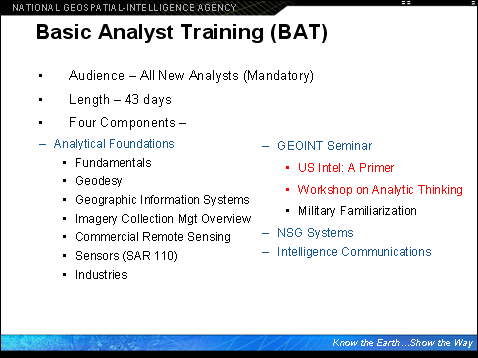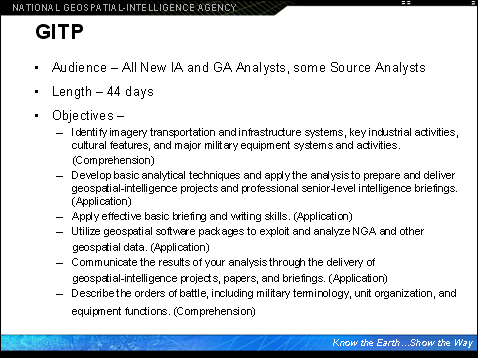The Intelligence Process-A Macro Look: Who Does What for Whom?
As you read Lowenthal's chapter 4 that discusses "The Intelligence Process-A Macro Look: Who Does What for Whom?" do some critical thinking and ask yourself:
- The US intelligence process has five steps and the author adds two. What is your evaluation of these steps? Are they the best combination and order of steps or can you think of alternatives? Why does the author add two steps? Why are his two additional steps not standard in US intelligence practice and doctrine?
- On page 62 the author notes, "The training and mind-sets of the analysts are important." How might analysts from different professional and academic backgrounds see things differently? How might a former military person see things differently from a civilian? How might a geographer see things differently from a political scientist or historian or an economist, etc?
- The US practices of dissemination have evolved over time. Why have they evolved as they have? What agency or agencies are advantaged or dis-advantaged through this method. Can you think of better ways to disseminate the intelligence?
Analyst Training
Reference the second bullet above on analyst's training, the NGA puts great emphasis on training their analysts. Review the slides below to see how the NGA trains their analysts.

Figure 04.01: Basic Analyst Training (BAT)
Source: National Geospatial-Intelligence Agency

Figure 04.02: Geospatial Intelligence Training Program (GITP)
Source: National Geospatial-Intelligence Agency
The NGA has its own college that offers a Master of Science of Strategic Intelligence Degree. This article from NGA's Pathfinder Magazine describes the first graduating class. The follow on news release announces Penn State's Graduate Certificate in Geospatial Intelligence. As you read these short articles ask yourself why are there multiple programs offered in geospatial intelligence? Are these programs redundant or do they fulfill different educational functions. Going back to your critical approach, do the different cultural filters and agendas of NGA versus academic programs influence the programs? Since NGA has its own masters program, why would they be so enthusiastic about the Penn State and other academic programs?
Up Front
Class Earns First GEOINT-Focused Master's Degree
By Thomas Schellingerhout
(NGA Pathfinder Magazine NOV-DEC 2006 page 9)The first-ever class to earn NGA's Master of Science of Strategic Intelligence (MSSI) graduated in ceremonies at the Joint Military Intelligence College Aug. 11. With this graduation milestone, NGA accomplished one of its goals in establishing and implementing within the Agency a master's-level degree program focused on geospatial intelligence (GEOINT).
The NGA MSSI program, accredited through the Joint Military Intelligence College, is the only GEOINT-focused master's program in the nation.
Completion of the MSSI field of studies provides numerous benefits for the graduating students. The 17 graduates will return to their respective organizations, bringing with them a heightened level of knowledge in the area of strategic intelligence as well as other intelligence-related topics. But aside from that, these students will also bring intangible benefits from this program as the MSSI education also prepares students for more challenging leadership roles within NGA and within the Intelligence Community (IC). And one other benefit: in addition to providing a master's degree, the MSSI also fulfills the Intelligence Community Officer Training (ICOT) requirement of the Intelligence Community Officer (ICO) designation-a significant milestone in NGA's professional integration within the IC.
What makes this program even more attractive to the workforce of NGA is that the MSSI two-year program is both tuition-free and done during duty hours. NGA students are given 16 hours of duty time per week to complete course requirements-a significant contribution by the NGA leadership to facilitate their education. Classes meet twice a week, at the Washington Navy Yard and in St. Louis, and incorporate the newest advances in information technology and video teleconferencing. Upon completion of classes, students are awarded the Post Graduate Intelligence Program (PGIP) certificate. For those students who complete their thesis requirement within the next term following their last class (students have five years to complete their thesis), the MSSI is awarded concurrently with their PGIP certificate.
The program is open to all NGA full-time employees who have two years of continuous federal service by the first day of the academic year being considered, who have completed their baccalaureate, and who have been approved by their supervisor. Applications are submitted through NGA Key Components to the Human Capital Management Board and Joint Military Intelligence College in the fall.
Thomas Schellingerhout manages the Master of Science of Strategic Intelligence program in St. Louis. A retired Army colonel, he works for Northrop Grumman as an education plans and programs specialist in the Career Development Department of the James R. Clapper Jr. School of Leadership and Professional Development.
Penn State Begins First Online Geospatial Intelligence Program
Wednesday, June 20, 2007
University Park, Pa. — In light of a greatly increased demand for qualified analysts in the intelligence, defense and emergency management fields, Penn State has developed a new online certificate program in geospatial intelligence (GEOINT). The five-course, 14-credit postbaccalaureate program is designed to provide students with the core competencies required to effectively and ethically provide geospatial analysis to key decision makers at defense, governmental, business and nongovernmental organizations.
Geospatial intelligence is a combination of remote sensing, imagery capture, geographic surveying and geo-political analysis. Its uses vary widely and can be applied to military planning, environmental resource preservation and even strategic retail store placement. Since a 2004 call to significantly increase the number of geospatial analysts in the government, the demand for qualified individuals has far outpaced the development of newly qualified professionals.
There is "a critical need" for this kind of educational offering, according to K. Stuart Shea, president and chairman of the U.S. Geospatial Intelligence Foundation (USGIF). "Programs such as this that orient students to a broad set of technical and critical thinking skills relevant to the geospatial intelligence profession will guarantee a robust and qualified workforce to meet the needs of the growing geospatial enterprise."
"There's a tremendous need to teach critical thinking and spatial problem solving, not just in the realm of defense," said lead faculty member Todd Bacastow. "Consider that practically everything that affects us has a location on the Earth. Where do you place your resources? How are events on the Earth related?"
Rather than simply developing students' proficiency with technology, Penn State's geography faculty want to develop students' abilities in critical thinking and spatial analysis, while promoting cultural sensitivity and high ethical standards to students in the field.
"We're moving past displaying data," explained Bacastow, "Our goal is to providing the critical insight that helps decision making and policy — and ultimately good choices."
The capstone course for the program is a virtual field experience. It will require students to problem solve a crisis situation modeled after real-world experiences — complete with unexpected curve balls thrown in by the instructors.
"Our goal is to educate someone in the concepts spatial analysis including critical, careful and complete thought," said Bacastow, "not a mechanical analysis of something without real understanding."
Penn State's Geospatial Intelligence Certificate program is the first online program of its kind in the nation. The certificate requires less than two years to complete, and is set to launch in the fall. More information is available at http://www.worldcampus.psu.edu/geo online.
Reading
Read Lowenthal's Chapter 4: "The Intelligence Process - A Macro Look: Who Does What for Whom?" in Intelligence: From Secrets to Policy 3rd edition. (Pages 54-67)